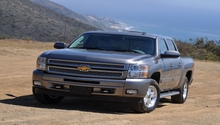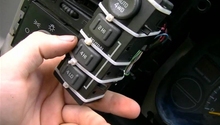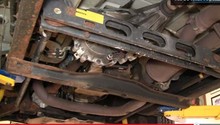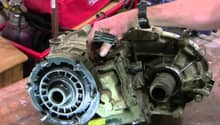Chevrolet Silverado 2014-Present: What is Wrong with my 4WD?
The 4WD in the Chevrolet Silverado is designed to get you out of trouble, but if something is wrong with it, you will need to diagnose it before you're stuck.
This article applies to the Chevrolet Silverado 1500 (2014-present).
The 4WD system is designed to get your truck out of trouble. If you get stuck in the mud, you engage the 4WD and all four wheels will be working towards your freedom. By engaging the transfer case in your Chevrolet Silverado, you’re essentially diverting half the power from the drivetrain away from the rear drive wheels. Just the mechanics of doing so adds to the level of road noise. But if this noise seems excessive, before replacing any 4WD components, here are some things to check out first.

Materials Needed
- Socket or wrench set
- Tire gauge
- Trolly jack and jack stands
- Transfer case fluid
- Clean shallow drain pan
Step 1 – Check the tires
Typical extra-large off-road tires with aggressive tread patterns and large lugs can offer great gripping power on rough terrain, but it will also create a fair amount of noise during normal highway use. But if in addition to road noise you notice a vibration or shudder upon attaining a certain highway speed, your tires could be to blame.
- Make sure all tires are inflated to the tire manufacturer’s specification.
- Check the condition of all the tires to make sure the tread pattern is wearing normally (equally across the top surface on all tires) and that there are no deep cuts or metal objects embedded in the tread lugs, such as nails or screws (big tires with large lug patterns do seem to attract hardware, for some reason).
- Make sure all tires are the same size; at the very least, both front tires should be the same size, and both rear tires should be the same size.
- Make sure all lug nuts are tight. Even though larger wheels may have more lug nuts, they still have the ability to come loose all on their own.
- Have your wheels realigned, especially if you’ve recently done some suspension work.
- If all tires are the same size, exchange two tires from opposite ends to see if the shudder goes away. If it doesn’t, rebalancing the tires might do the trick, as over time tires will come out of balance — plus one or more wheel weights could have fallen off.
On occasion, new trucks that sat on a dealer’s lot for a lengthy bit of time may have developed “flat spots” on their tires. Usually, putting a number of miles on them will correct this condition, but sometimes it does not. If you suspect your new truck’s tires have flat spots that create a noise and shudder with each rotation, be sure to have your dealer check this out while the vehicle is still under warranty.

Step 2 – Check the operation of the transfer case selector switch and DIC
Don’t ignore the behavior of the controls used to put the Silverado into and out of 4WD, as well as related IP warning lights.
With the Transfer Case Selector Switch, make sure that:
- If when you put it in “Auto” it blinks for a bit then stays lit — or if it doesn’t blink, or blinks then turns off — you might have a problem with the front axle actuator.
- If when you put it in 4-High or 4-Low it doesn’t light, or if it blinks then turns off, you might have a problem with the transfer case shift motor/encoder.
- If when you put it in 4WD nothing happens with the switch, but the “Check 4WD” light comes on in the DIC, you might have a problem with the transfer case control module, located behind the dashboard near the location of the transfer case selector switch.
But before replacing any switch or controller, make sure that the ground connection going to it is viable. The ground wires for the selector switch and TCCM are attached to the frame under the front of the driver’s door. Unbolt these wires, clean their contact area to bare metal as well as the bolt threads, and reattach the wires to the frame (5 minute job).

Step 3 – Check the condition of the transfer case
If the transfer case makes a grinding noise when in four-wheel drive, this could indicate a serious problem. Make sure that:
- The shift motor/encoder is functioning. When you turn the transfer case selector switch you should be able to hear the shift motor/encoder attached to the transfer case select the proper drive mode.
- The transfer case has the proper amount of fluid in it. With the vehicle level, remove the top fill plug and place your index finger into the opening. You should be able to touch fluid. If it’s low, fill it with the proper GM or equivalent transfer case fluid.
- If the transfer case fluid is too low to touch, remove the lower drain plug and pour some of the fluid into a shallow pan. Check the fluid in the pan for small metal particles; if there are any, it’s a good indication that your transfer case needs to be rebuilt or replaced.

Related Discussions
- Discussion About 4WD Rear End Noise - Chevroletforum.com
- Discussion About 4WD Vibration Issues - Chevroletforum.com






